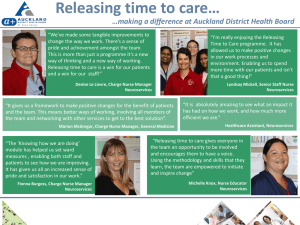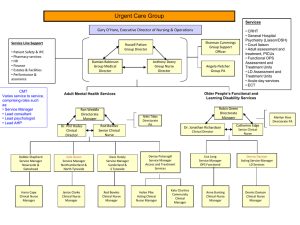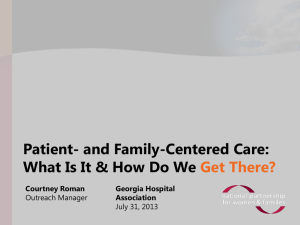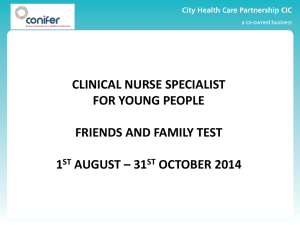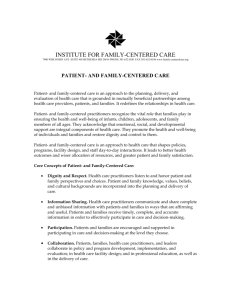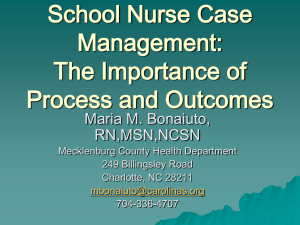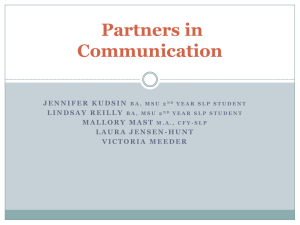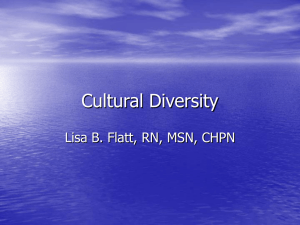Thinking Like a Nurse Means Thinking About the Family Jane Ball
advertisement
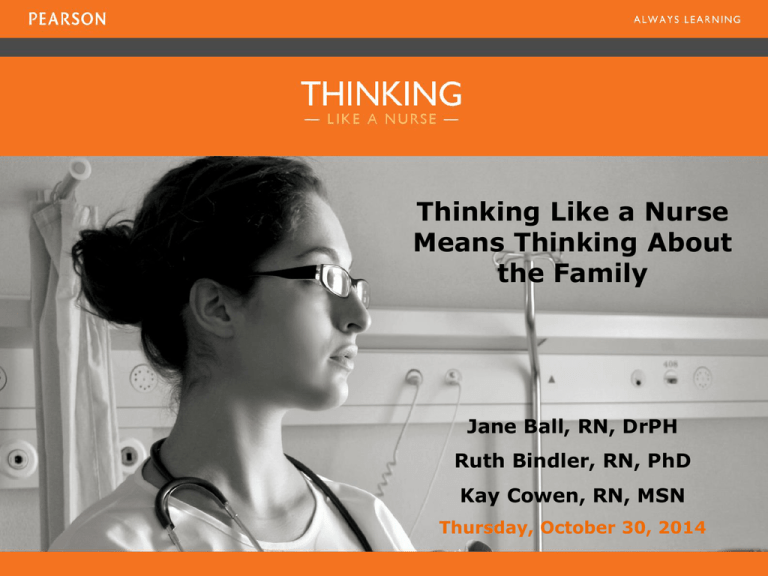
Thinking Like a Nurse Means Thinking About the Family Jane Ball, RN, DrPH Ruth Bindler, RN, PhD Kay Cowen, RN, MSN Thursday, October 30, 2014 Jane Ball, RN, CPNP, DrPH Ruth Bindler, RNC, PhD Kay Cowen, RN-BC, MSN “Often when nurse educators hear family-centered care, they automatically think, "pediatric nursing", but a focus on the family is important to nearly all patient populations. Furthermore, a familycentered clinical mindset is key to improving clinical reasoning and judgment as it expands thinking beyond an individual point of care moment to include broader considerations that may impact patient care.” OBJECTIVES • define family-centered care and its importance in caring for patients; • provide examples of how family-centered care considerations translates into general patient care; • demonstrate how population health concerns may impact families and individual patients • share patient teaching examples of how to transition the adolescent patient with chronic conditions to adult services; • share active teaching strategies to reinforce family-centered care across the curriculum Defining “Family” •Many definitions of family exist. •A family is usually a self-identified group of two or more persons joined together by shared resources and emotional closeness. •Family members may or may not be related by blood, marriage, or adoption, and in some cases they do not even live in the same household. •What is important is that family members depend upon each other for emotional, physical, and economic support. •Families are guided by a common set of values or beliefs about the worth and importance of certain ideas and traditions. •Examples include one parent families with children, traditional families with two parents, families with multiple generations residing together, and gay or lesbian couples with children. Defining “Family-centered Care” • Family centered care is a deliberate and dynamic approach to building collaborative relationships between the nurse (or other health professionals) and families. • This approach must be respectful of the family’s diversity and their beliefs about the nature of the child’s health conditions and how to manage them. • Family-centered care extends to all patients family care for: – families with young children who are unable to participate in decision making about the care they receive. Parents are expected to be responsible for the care of children, but they need guidance from health professionals to plan ways to provide care at home in a manner that meets the needs of the child and also fits within the family’s life and routines. – Adults who are hospitalized for an acute illness or surgery and are discharged early in the recovery process and need monitoring and care when in the home – a family member is usually expected to provide that care. The nurse needs to develop a collaborative relationship with the family to ensure proper care is given after the patient is discharged. The Gonzalez Family • The family emigrated from Mexico seven years ago and all are now U.S. citizens. • Family members: – grandmother, Inez, who works in the fields at times, but due to her age and frailty, often remains home to do the cooking and housework; – mother and father, Julio and Maria, work in the fields every day that they can, during the winter there is little work but they make cheese from their goats and work in various jobs as available; – 3 children – Gemma, a high school junior; Ricardo, who is in 7th grade; and Isabella who is in 2nd grade. • Gemma does well in school but the school nurse is concerned that she is quite overweight. Gemma claims she does not like the food that her grandmother makes, and uses her spending money to buy fast food as she walks to and from school. She rarely exercises except in PE which she dislikes. • The entire family became ill after consuming homemade cheese made by Inez and wants to know how to avoid that problem. Family-centered Nursing Intervention • The school nurse meets with Gemma and learns that she wants to lose weight but has little knowledge about how to do that. – The nurse identifies an after school program with “fun” activities and healthy snacks that appeals to Gemma. – The nurse also assists the family in completing forms for reduced cost breakfast and lunch, and Gemma becomes enrolled in the program. Gemma thought that if she got school lunch her friends would know she was poor but the school has a card system that keeps the payment option for each student private so she became receptive to eating there and decreasing fast food snacks. – The nurse also learns that the farmers have a gleaning program and allow the workers to collect edible but slightly bruised fruits to take home to the family. She informs the parents who take this opportunity and provide fruits for each child to take to school daily. • Obesity in youth is almost always associated with eating and physical activity patterns as well as family roles all must be considered. In this extended family, the grandmother had a major role for preparing food, and the teen was, as typical teens are, influenced by concerns about peer expectations. An intersection of family needs, development, and cultural mores was important to consider. • Also, there are several contaminants that can be present in homemade cheeses, the major one which is Listeria. Several of the land grant universities in the west have had classes and produced videos about how to prepare homemade cheese safely. The school nurse worked with the community health nurse who provided this information for the grandmother, Inez, and then showed it at a community forum for many of the farmworker families. The Marcos Family • The Marcos family from the Denver area has multiple adults and children living as an extended family, includes: • the grandparents, the parents of Emmi, Mannie, and Zeke who are 6, 9, and 12 years old, and the parents of Thomas, Joseph, and Reina who are 7, 12, and 16 years old. • Reina is pregnant and expecting a baby in 3 months. The baby’s father is 18 years old and is attempting to make efforts to assume responsibility for Reina and the baby. • The parents of both sets of children work in a variety of settings, such as food service, day care, home care for seniors, and environmental services. • The grandparents also work, and all family members participate in food preparation for the family and jointly caring for each other’s children. • The family is also very active in their community church and with other extended family in the area. Family-centered Care Considerations • The Denver area has been experiencing a pertussis (whooping cough) epidemic in young infants and children who have not been immunized. • Many adults who might have been immunized with the pertussis vaccine as children no longer have active immunity as the vaccine effect has diminished. In recent years an adult formulation of the tetanus- diphtheria vaccine was developed that also includes the acellular pertussis vaccine. Many adults only receive a tetanus injection in association with an injury. • The nurse caring for Reina at the OB clinic is interested in helping Reina to protect her newborn from developing pertussis which can be life threatening at that age. Guidelines from the CDC recommend that adolescents and adults who are likely to have close contact with an infant aged <12 months old should receive a single dose of Tdap to protect against pertussis if they have not previously received this vaccine, optimally at least 2 weeks before the baby’s birth. Family-centered Nursing Interventions • The nurse asks Reina to find out information about the immunization status of her parents and grandparents. If they have not received the Tdap vaccine, she encourages Reina to ask them to get the vaccine. • Reina soon learns that the grandparents and 2 of the parents have not been immunized. Reina reports this information to the nurse on her next visit, and the nurse then informs Reina that the vaccines can be obtained at a local pharmacy or health department clinic. • Reina’s OB nurse practitioner provides a signed prescription for each family member needing the vaccine to make it easier for them to obtain it. • This family-centered care strategy illustrates the importance of adult immunizations and their role in protecting all members of the family. Transitioning the Adolescent Patient • • • • • • • Mark is 17 years old and a junior in high school has cystic fibrosis living with his mother, stepfather, and 2 sisters, one of whom also has cystic fibrosis. Mark has been fortunate to live in a city with a cystic fibrosis specialty clinic at the university hospital. Mark’s mother worked carefully with the health professionals in the CF clinic to provide all the recommended treatments and find ways to fit them into a schedule that made sense for Mark’s school day and family activities. For respiratory therapy, he uses a bronchodilator and inhaler to moisten secretions, followed by a oscillating vest 3 times a day to loosen secretions that he must cough up. Mark’s mother is very much engaged in ongoing management of Mark’s condition and has provided the high caloric diet and other medications needed to keep his condition under control. Mark has a gastrostomy tube to ensure that he receives the extra calories needed for his adolescent growth spurt and to promote his resistance to infection. His pediatrician worked collaboratively with the cystic fibrosis clinic to provide routine health care as well as treatment for respiratory infections that frequently develop and wants to transfer Mark to an adult primary care physician when he is 18. At this time, it is not known if or when Mark will be expected to live independently after he graduates from high school and looks for a job. Mark has relatively frequent episodes of respiratory infections, and he will be limited to finding a job that does not require much physical effort. The nurse in the CF clinic has begun working with Mark and his mother on a transitional health plan that includes identifying a new primary care physician, but he will continue to receive some specialty care through the CF clinic. This transition process is likely to take several visits over a year. Mark needs a plan to take total responsibility for his care. When you have an individual with a life-limiting condition, what is the role of the family? How challenging will it be for his mother to stand back and serve as Mark’s consultant rather than the manager of his care? Family-centered Care Questions: Transitioning Adolescent Patients • When you have an individual with a life-limiting condition, what is the role of the family? • How challenging will it be for his mother to stand back and serve as Mark’s consultant rather than the manager of his care? • What happens when Mark has an acute episode related to CF or diabetes mellitus? • Will Mark’s mother still be available to assist him during the recuperation? • What if Mark develops a significant relationship with someone and moves out of the family home? • How would that new family member become educated and integrated into Mark’s care plan? Family-centered Care based Active Teaching Strategy #1 • Have students follow a family for their entire curriculum or for a semester or two. • If a child has asthma, the student can study the pathophysiology of the condition, the medications and other treatments, and can attend healthcare visits with the child. • The student also should interview everyone in the family with questions such as history of allergy in family members, use of tobacco products (either in or outside of the home), adult employment and exposure to contaminants on clothing. • Questions for the student to have answered: – Can parents get away from work when necessary to seek care for the child? – Do family resources allow for insurance coverage of treatment and for getting to appointments? – Where does the family live? – Does that increase the chances of asthma occurring? – What environmental factors can be altered and which cannot? • Seeing the trajectory of the illness, the influence of the family situation on the illness, and the influence of the illness on the family are powerful learning opportunities. Family-centered Care based Active Teaching Strategy #2 • Healthy People 2020 provides clear data and objectives for many conditions. Have your students seek out the leading health indicators for oral health for example. • Oral Health (OH) Objective 7 states “Increase the proportion of children, adolescents, and adults who used the oral health care system in the past year.” • Using the data from the HP2020 website, the student will learn that only 44.5% of children meet that objective, but the nation is striving to increase this number to the goal of 49%. Students can then research ways that families access oral health care, find resources in their communities, and learn about the relationship of poor oral health to other diseases. Tie the HP2020 goal to the student’s goal or objective for care in their nursing care plan. Linking HP2020 to families, your own communities, and pathophysiology ties all of these factors together for students. Family-centered Care based Active Teaching Strategy #3 • Have your nursing students work in a group with students in pharmacy, physical therapy, occupational therapy, social work and medicine. • Assign a Team Challenge such as the scenario involving a child with asthma who wants to complete a local 5 mile fun walk. • Write the scenario so that each profession can contribute their specialty's unique knowledge about asthma and how the goal can be met.
